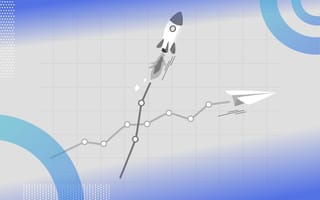As more digitally native generations enter the workplace, they will continue to want more autonomy in the sales process than their predecessors. In fact, 71 percent of B2B buyers would rather educate themselves than learn about a product from a sales rep. For SaaS companies, this means it’s crucial to adopt a strategy that meets consumers’ changing needs if they want to stay competitive. The product-led growth model enables such buyers to make those autonomous decisions about their technology.
If you aren’t currently executing, or even considering, a product-led growth strategy, here are three reasons you should be.
Product-led Growth Does 3 Big Things for Your Company
- Compresses the sales cycle
- Increases brand credibility
- Forces product excellence
1. Product-led Growth Compresses the Sales Cycle
The average sales cycle for SaaS companies is around 84 days. This means your team spends nearly three months trying to acquire one new customer. One of the many benefits of PLG is that it enables your business to scale faster. In the sales process, using a product-led growth strategy can cut down the time it takes your team to close a deal. The first step in using product-led growth to compress the sales cycle is to adopt the right mindset. You must aim to truly understand and solve your users’ problems if you plan to execute a PLG strategy. When the power of the sales process lives with your buyers, your product, company message and marketing content must speak for themselves. Having a cohesive message about how your solution addresses your audience’s biggest pain points will ensure they come to you when they’re ready to buy.
Companies such as Hubspot and Slack that have adopted a flywheel approach to customer engagement have moved beyond their peers, delivering higher levels of customer adoption and satisfaction with growth fueled by their passionate users.
2. Product-led Growth Increases Brand Credibility
Modern buyers are skeptical of the marketing messages they encounter, which makes building brand credibility more challenging than ever. Today, only 3 percent of buyers trust business representatives, but 92 percent trust referrals from people they know. A PLG model establishes credibility by putting your product’s value in the hands of your users and encouraging them to share their success with others.
With product-led growth, end users are your biggest advocates. The most successful companies executing a product-led growth strategy build credibility through their end users. Take brands like SurveyMonkey (now Momentive.ai), Calendly, or Dropbox, for example. Chances are the first time you’d heard of these companies was when a link to fill out a survey, schedule a meeting, or access an online folder was shared with you.
In a PLG model, the majority of growth comes from word-of-mouth and encouraging users to share the product. Ensuring product-led growth increases your brand’s credibility starts with understanding your users’ needs and expectations. Through product data and user feedback you can uncover their biggest pain points and better position your product to help them quickly overcome those hurdles. By delivering value as soon as possible, your users will likely pass their good experience along.
3. Product-led Growth Forces Product Excellence
The product is the heart of every SaaS company. In a PLG strategy, the product has to speak for itself. This means that it must be user-friendly, solve their problems and do so faster than any other solution in the market. The product-led growth model ensures your solution is in top shape. Though, this is only possible if your team is aligned on your end users’ needs and expectations. When the entire team is armed with valuable user information, you can build an exceptional user experience.
While organizations take many different approaches to amplify their growth, they all have one common goal: sell more while continuing to solve problems for current customers. When it comes to reaching that goal, and doing it well, product-led growth is a winning strategy. By focusing on your end users, listening to their feedback and creating a solution to solve their problems, a product-led growth strategy is a critical component in scaling your business and ensuring it thrives.





